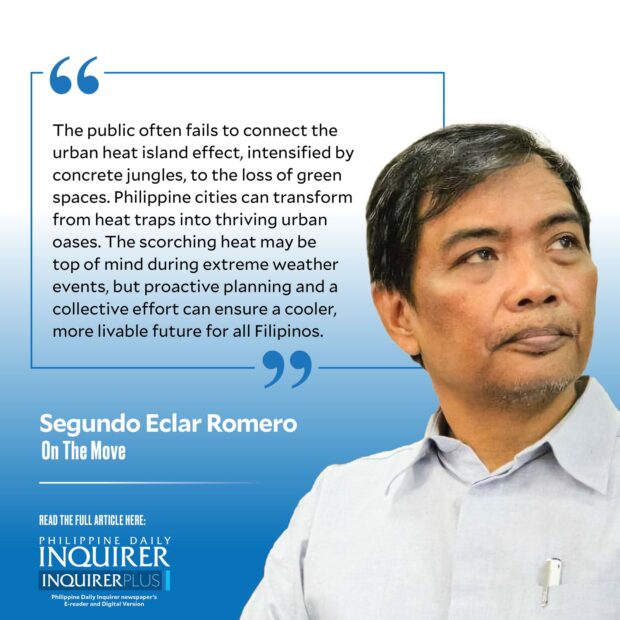
The Philippines is facing scorching heat fueled by El Niño and worsening climate change. Last Sunday, the heat index was “dangerous” at 43 degrees Celsius in Manila but “extremely dangerous” at 53 degrees Celsius in Iba, Zambales. We are advised by the Philippine Atmospheric, Geophysical, and Astronomical Services Administration that at these temperatures, heat cramps and heat exhaustion are likely and heat stroke is probable or even imminent. The heat is significantly worse in urban areas because of the heat island effect—the condition where areas characterized by extensive surfaces covered with asphalt, concrete, and tiles absorb and retain heat from the sun, leading to higher temperatures.
The usual escape tactic of Filipinos is to go to the heat “bomb shelters”—air-conditioned malls, clearly an unsatisfactory palliative solution. One of the critical ways to reverse the degradation of our environment and the larger threats of climate change is to put ourselves in a combat frame of mind. We must win back lost territory space by space, meter by meter. One tangible way of doing this is greening our cities. The best way to do this is to reclaim, expand, protect, and sustain our urban green spaces.
Urban green spaces are the lungs of our cities. Traditionally, parks, playgrounds, gardens, and public green areas were the mainstays of urban green spaces. Now, the definition embraces everything from street trees and bioswales (meaning, planted medians that filter rainwater) to green roofs and vertical gardens. Even vacant lots can be transformed into community gardens.
The key weapon in reclaiming lost greenery is innovation. The first task is innovation in acquisition. Cities are getting creative with land acquisition. Public-private partnerships and land banking strategies help secure spaces, while innovative financing mechanisms like green bonds raise funds for green infrastructure.
The second task is innovation in design. Multifunctional green spaces are the trend. Parks with community gardens, rainwater harvesting features, and dog parks cater to diverse needs. Pocket parks in underutilized areas maximize green space in dense neighborhoods.
The third task is innovation in maintenance. Low-maintenance native plants (like the “designer” street trees of Marikina) and community involvement in upkeep reduce costs and foster a sense of ownership.
Retrofitting urban green spaces is second best to designing urban green spaces into master plans. Urban green spaces should no longer be afterthoughts. They should be incorporated into master plans from the get-go, ensuring a well-connected network of green corridors throughout the city.
An important niche for urban green spaces is transit-oriented development. Green spaces should be integrated with public transport hubs, encouraging walking and cycling, creating a healthier and more vibrant urban environment. Lately, there has been a surge in the construction of new highways and skyways in Metro Manila. Couldn’t all this concrete been designed to incorporate green space features?
Now that the Pasig River Expressway project has been abandoned, could that space now be transformed into an urban green corridor, an esplanade similar to the Iloilo River Esplanade or the Marikina River Park? Also, the huge reclamation projects in Manila Bay and the construction of the new Manila International Airport in Bulacan present potential opportunities and challenges for creating new urban green spaces.
It is not enough that we grow urban green spaces. We must ensure they are inclusive. First, this means creating green spaces in underserved communities and prioritizing projects with high social impact. Oftentimes, the best we can do is pocket parks, but small as they are, they can be an oasis in the desert.
Second, program diverse uses for green spaces like fitness classes, farmers markets, and cultural events make green spaces vibrant community hubs. The same green space can be stretched to serve an unbelievable number and types of people—playgrounds with rubberized surfaces to delight children, while quiet paths lined with benches cater to those seeking solace.
City authorities often prioritize issues with tangible consequences, like floods and waste management. Heat, however, receives less attention. The public often fails to connect the urban heat island effect, intensified by concrete jungles, to the loss of green spaces. Philippine cities can transform from heat traps into thriving urban oases. The scorching heat may be top of mind during extreme weather events, but proactive planning and a collective effort can ensure a cooler, more livable future for all Filipinos.
doyromero@gmail.com